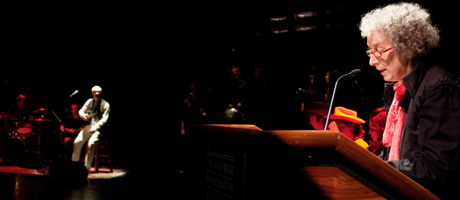By Jaime Gacek
If you wonder what the future may bring, picture this: A man-made pandemic, gene-spliced animals that grow human hair, and an eco-conscious religious group that considers Al Gore a saint.
This disturbing dystopia is the latest literary vision of author Margaret Atwood, who performed a special reading of her new novel The Year of the Flood at Lisner Auditorium on Oct. 30.
Ms. Atwood, who has written more than 40 books of fiction, poetry and critical essays, worked with GW students to transform her most recent vision to the stage. Students sang in a gospel-inspired choir, rocked out on the bass and drums, and dramatically read key passages of the book while Ms. Atwood narrated.
The performances have been held around the country to promote the book. Each group receives the script and music in advance, but “they choose how to use it, how to interpret it,” she said. GW is the first and only university to participate.
For a dramatic production, it certainly wasn’t the same song and dance. Three theater students took on at least eight characters, reading and acting out the complicated hardships that force survivors of a deadly plague to endure in their new environment. The story focuses on God’s Gardeners, a group from Ms. Atwood’s 2003 novel Oryx and Crake who attempt to reconcile religion, science and nature.
“There always were, in the major religions of the world, these roots in the natural Earth,” Ms. Atwood said, explaining that her faux religion “grows on to ones that exist.”
These eco-conscious crusaders even have their own hymns, which were sung during the performance by a dozen or so GW students on stage with a band led by the musical composer and Ms. Atwood’s friend, Orville Stoeber. For a story about the Earth’s imminent demise, the music was unusually uplifting, inspiring audience members to clap to the beat.
After the hour-and-a-half-long performance, Ms. Atwood, who wrote the Booker Prize-winning The Blind Assassin and The Handmaid’s Tale, took audience questions. One fan asked whether the author thought The Year of the Flood was less bleak than Oryx and Crake.
On the eve of Halloween, Ms. Atwood, dressed in black, answered in a steady, monotone voice. “There are more people left standing at the end,” she said to audience laughter. “But it depends what your benchmarks for bleak are.”


